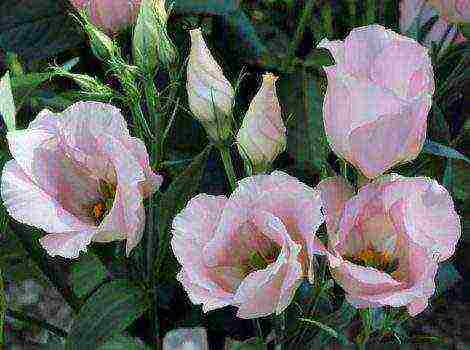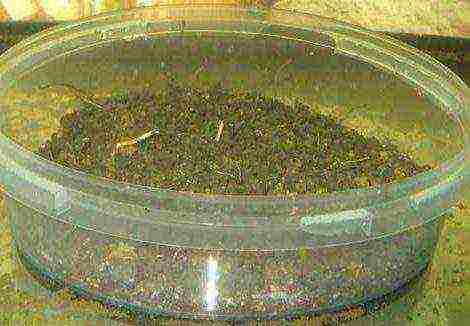Content
- 1 What is Pepino
- 2 Why is pepino useful?
- 3 Growing
- 4 Outdoor cultivation
- 5 Suitable soil
- 6 Ramses variety
- 7 Consuelo variety
- 8 Propagation by cuttings
- 9 Seed propagation (germination)
- 10 Planting seeds
- 11 Fruiting
- 12 Use
- 13 Reproduction of Pepino
- 14 Soil preparation and planting seedlings
- 15 Protection from pests and diseases
- 16 Preparation of mother plants
- 17 Preservation of mother plants
Now a lot of exotic plants have appeared, which summer residents and gardeners are trying to grow on their plots. This experience is not always positive, although cultivation is usually not a problem. These plants include pepino. Growing this fruit at home is not difficult. This fruit tree has existed for quite some time, and it is worth noting that this is not a hybrid that breeders have bred. True, pepino has been cultivated in our regions relatively recently, therefore, some agrotechnical subtleties are known to few.
What is Pepino
It is a medium sized fruit that has a sweet melon flavor and aroma. But for this, the fruits must ripen very well, which is quite problematic in some areas of our country. However, this does not prevent some gardeners from feasting on delicious pepino from year to year. The ripe fruit aroma is also very expressive. This is how his maturity can be determined. If there is no aroma, then the fruit is not yet ripe. The color of a pepino depends on its degree of maturity. In a ripe fruit, it is bright, rich, yellow-orange. This pepino is eaten fresh as a dessert. If the fruit did not have time to ripen due to weather conditions, then it is used as an ingredient in salads. Melon pear - pepino - has different sizes and weights up to 0.5 kilograms.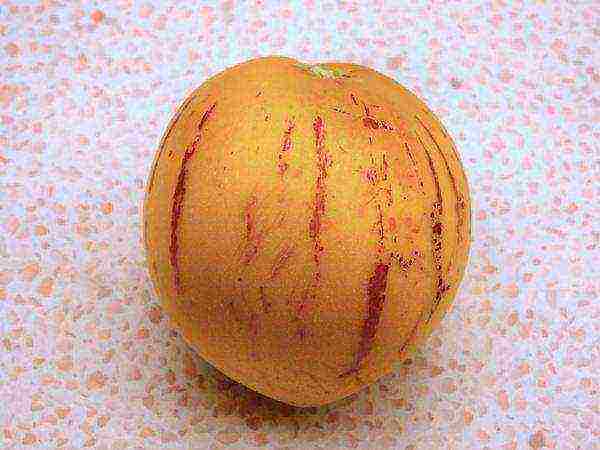
Why is pepino useful?
The pepino fruit contains a lot of nutrients. So that they are well absorbed by the body, it is better to eat it during the day, before 6 pm. This fruit contains virtually no protein. Their mass is only 0.3-0.4 percent. There are no fats in pepino at all. Carbohydrates make up 6 percent of the total mass, and they also cannot be called the main components. The value of pepino lies in the content of vitamins B, A and K. This fruit contains a very large amount of vitamin C, as well as iron, potassium, copper and magnesium. Therefore, pepino, which can be grown at home, is not only tasty, but also a healthy product.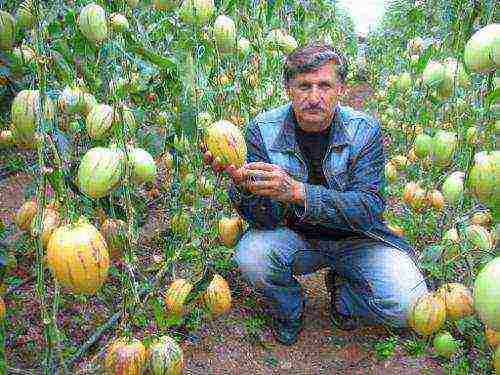
Growing
Melon pear (pepino) is small in size. This plant can be grown both in greenhouses or open field, and on a windowsill. Fruits are harvested throughout the season, since their ripening time is not the same. Pepino's skin is very thin, and there are few seeds. The pulp is very tasty and juicy. This made the fruit unusually popular among gardeners and gardeners.
This is a tropical plant that does not like a strong drop in temperature. Therefore, it is better to breed pepino in greenhouses, on glazed balconies or terraces. The temperature should not be lower than 14 degrees. Also, the plant requires high humidity of both soil and air. Temperature fluctuations should not be strong, especially during the growing season.
Outdoor cultivation
Many experienced gardeners grow pepino outdoors with good results. Some people manage to collect up to 7 kilograms of fruit from one bush. Despite the fact that it is a tropical plant, it does not tolerate extreme heat. Regardless of watering, pepino blooms during the hot months, but the fruits are not tied, and the flowers fall off.More active ripening of fruits begins in early autumn, in September and October. Pepino does not tolerate strong gusts of wind very badly, because the root system of the plant is shallow and forms in the upper layer of the soil.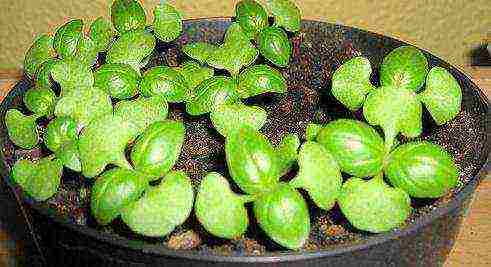
Suitable soil
What kind of soil does Pepino like? Growing at home should be organized in light, fertile areas with good drainage. Waterlogged soils with low oxygen content due to their high density are not suitable for this fruit. Excess moisture leads to decay of the root system. Therefore, watering should be carried out as needed. You can spray the plant, since air humidity is vital for it, especially in dry months.
Ramses variety
Are there varieties of pepino? Growing at home is possible, and for this, two varieties of culture are used. One of them is Ramses. It is a very productive variety with high yields. It is resistant to adverse factors of influence. The fruits are medium in size and yellowish-orange in color. Pepino Ramses is distinguished by delicious, juicy pulp with a slight peppery flavor. This variety is ideal for home cultivation.
Consuelo variety
The second most polar cultivation variety is Pepino - Consuelo. It is also successfully grown in our regions, achieving good yields and sufficient fruit ripeness. Consuelo has bright yellow fruits with light purple stripes. The conditions for growing this variety must be very favorable, otherwise it will not be possible to achieve fruiting. But nevertheless, this is one of the most commonly used types of pepino in home breeding. Subject to all agrotechnical requirements, it can bear fruit regularly. Better to use Consuelo for indoor cultivation.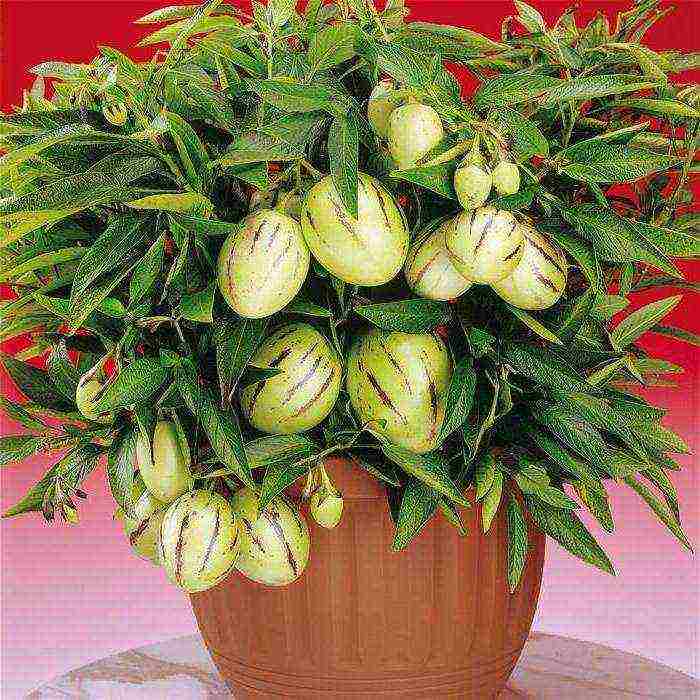
Propagation by cuttings
Pepino is propagated by both seeds and cuttings. Sometimes the second way is preferable. The seeds in our regions are unripe. In autumn, cuttings are planted in pots with fertile and light soil. They are placed on the windowsill on the south side. Do not forget that pepino is a tropical plant that loves warmth. After two or three weeks, the cuttings will take root. It is better to cover them with foil at first. So they better adapt to new conditions. Rooting time depends on many conditions: temperature, watering and soil quality. Cuttings are planted in open ground in mid-May or a little earlier. It all depends on the weather conditions. It is better to place them under a tree with a sparse crown. This will provide the plant with enough warmth and light, but also prevent it from suffering from the heat during the hottest months. This is how pepino is propagated. Growing at home in this way is quite simple and affordable.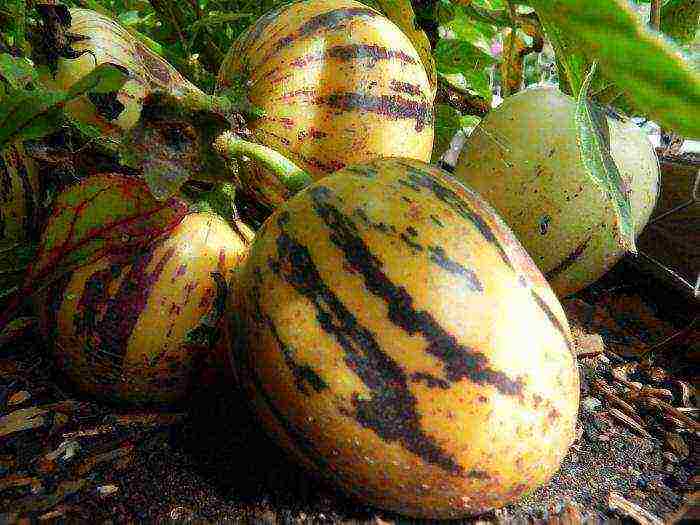
Seed propagation (germination)
The second breeding method is a little more complicated. Growing pepino from seeds is laborious, and their germination rate is low. Even if you specially germinate the seeds, the productivity will still not be very high. The seeds in our climatic conditions do not receive sufficient maturity, which leads to such results. But if you have patience, then you can grow a wonderful pepino in this way.
Seeds germinate for a very long time. It takes up to one month for the first signs to appear. Preparation of seeds for planting is important here. True, when sowing, only a few germinate into the soil. Plastic cups or jars can be used as containers. The bottom of the container is lined with filter paper, which is moistened with water. Seeds are laid in it and they are removed in a warm place where the temperature does not exceed 28 degrees. When shoots appear, the containers are moved under a fluorescent lamp. The seeds should lie there until a good sprout appears and the seed splits in two.If necessary, you can help the plant to get rid of the seed peel, but this must be done carefully.
Planting seeds
When the plant is completely free from the peel, it is planted in the ground in order to obtain seedlings. It must be pre-treated with a hot manganese solution. Plant development is slow, and it needs artificial lighting up to 16 hours a day. After a month and a half, seedling growth accelerates. During this time, you need to carry out several dressings with mineral fertilizers. If stepchildren appear during the growth period, they are removed. Pepino should not have more than three stems. The fewer branches there are, the faster flowering will begin and fruiting will occur. Pepino is planted at the same time as tomato seedlings. This is a thermophilic culture, therefore, it should not be exposed to spring frosts. The care requirements for pepino are the same as for tomatoes. This plant also requires garter and pinching. The entire period is important: preparation of seeds for planting, germination, receiving seedlings and planting in the ground.
Fruiting
Fruit setting usually occurs in late spring and early autumn. In summer, pepino does not form ovaries due to extreme heat. Fruits that appear in spring ripen in early June. Therefore, it is very important to plant the pepino as early as possible. Autumn fruits usually do not have time to ripen, especially in the open field. Therefore, it is necessary to make every effort to obtain a harvest from the spring ovary, or to grow pepino in closed ground.
Use
What is made from pepino? How is this fruit eaten? If harvested correctly, the fruits are very tasty and raw. The peel must be removed before use, and do not forget to remove the seeds. Unripe fruits are used to make jams or salads. New Zealanders prepare soups, sauces from fruits and serve them with seafood and meat. In addition, pepino is salted, frozen and dried. And also delicious jams and compotes are made from this fruit.
Long-term communication with pepino made it possible to learn (although not completely) its biological characteristics, cultivation technology. But the main thing is that a perennial shrub semi-lignified plant, an inhabitant of the southern area, was able to adapt to our conditions and cultivate it as an annual plant in the open field, obtaining a harvest of wonderful fruits.
The agricultural technology of a new culture for us is similar to the agricultural technology of tomato, with the exception, perhaps, of the preservation of mother plants in the winter.
 Pepino, Melon Pear or Sweet Cucumber
Pepino, Melon Pear or Sweet Cucumber
Reproduction of Pepino
Pepino can be propagated by seeds and cuttings. Seeds from grown fruits have high sowing qualities - germination and germination energy. We sow seeds in late January — early February in a light and loose soil mixture. They are small, so we do not embed them in the soil, but only lightly sprinkle them.
To preserve moisture, cover the vegetation with foil or glass. The optimum temperature for seed germination is 26-28 ° C. Seedlings appear in 5-7 days. In the phase of two or three true leaves, we dive the seedlings into pots and cups, deepening them to the cotyledons. For the prevention of black leg disease, we use steamed soil mixture or pre-spill it in planting containers with a solution of potassium permanganate. Cover the dived seedlings with a film (over the arches) to maintain air humidity and better survival of the seedlings. In the first month, they grow very slowly and by the time they are planted in open ground, they reach 8-10 cm in height, forming 7-8 leaves.
We have now made it easy to grow seedlings. After checking the germination of seeds, we sow at once 2-3 pcs. in cups. In them, plants develop (without picking) before planting in open ground. Additional lighting helps to speed up the development of seedlings. Time is saved and the root system of plants is not injured once again.
 Pepino, Melon Pear, or Sweet Cucumber
Pepino, Melon Pear, or Sweet Cucumber
To grow pepino from seeds in protected and open ground, you should be aware that even under favorable conditions, not all pepino varieties produce full-fledged seeds. Due to the splitting of varietal traits, seedlings not only bloom late, but also form heterogeneous fruits, which leads to a loss of the purity of the variety.
The safest way to propagate and grow pepino is by rooted cuttings. Separating cuttings from overwintered plants should be started in mid-February. To do this, cut off the tip of the shoot with 7 leaves. Remove the bottom 2 leaves, and shorten the next 2-3 by half to reduce moisture evaporation. With a lack of mother plants, the lower part of the shoot with 4-5 internodes can also be used as planting material, also removing and shortening the leaves.
It is best to root the cuttings in a standard cutter, if not, in a shallow container. Do not place the cuttings tightly in the container. There should be enough water so that the lower leaves of the cuttings do not sink into it.
Pepino cuttings root almost 100% without any stimulants. At normal room temperature (20-24 ° C) after 5-7 days, roots grow in large quantities on the cuttings with a length of 1.5-2.0 cm or more. This is the most favorable time for planting rooted cuttings in seedling pots or plastic disposable cups. In the bottom of the cups, you need to make several small holes to drain excess water when watering. The soil in the seedling container should be as loose as possible, since pepino roots are sensitive to a lack of air in the substrate.
 Pepino, Melon Pear, or Sweet Cucumber
Pepino, Melon Pear, or Sweet Cucumber
Cuttings can be planted in seedling containers without rooting in water. In this case, they need to pay more attention. Cuttings should be kept in moist soil and high humidity. Such cuttings take root within two weeks. It should be remembered that containers with rooting cuttings, planted with rooted cuttings should be under the film to maintain the necessary high humidity during this period.
Soil preparation and planting seedlings
Pepino prefers light, fertile soils with neutral acidity. The best predecessors are crops harvested early: cucumber, onion, garlic, beans. After harvesting the predecessor, the soil is loosened, we cleaned it of weeds, if possible we dig it up before the onset of cold weather.
In the spring, when the soil is ripe, we loosen it to retain moisture before planting. Before planting seedlings in the place of future rows (the distance between them is 70 cm), we prepare shallow trenches for a double width of the shovel and add organic fertilizers to them: after the fertilized predecessor - well decomposed manure or compost - 3-4 kg / m2, after the unfertilized - 6— 7 kg / m2 and ash.
We plant seedlings in open ground in early May, when the threat of return frosts has passed. We orient the rows from north to south, arrange the seedlings in a checkerboard pattern, deepening 2-3 cm lower than they grew in the container. We plant seedlings in moist soil in the afternoon or evening. The distance between plants in a row is 40-50 cm. After planting, water and mulch the plants with dry soil. At the same time, moisture evaporation decreases and the conditions for seedling survival are improved. Repeat watering in 2-3 days depending on weather conditions.
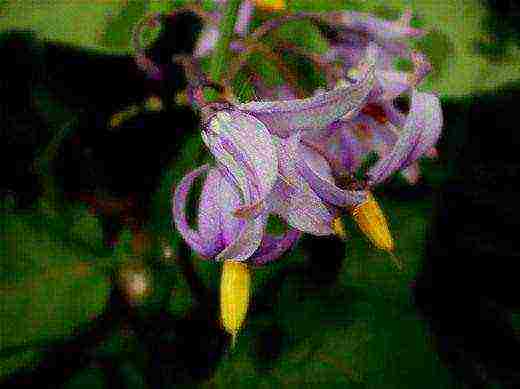 Pepino, Melon Pear, or Sweet Cucumber
Pepino, Melon Pear, or Sweet Cucumber
In recent years, we have been planting seedlings at the same time as tomatoes - in mid-April. This allows you to get ripe fruits 2-3 weeks earlier, as well as extend the growing season and thereby increase the productivity of plants. To protect the pepino from possible frost, we install a simple structure of wooden bars or reinforcing wire over the rows of planted plants and cover it with a film or spunbond. We put drip irrigation tape under the film along the row of plants. In such conditions, the plants take root well and start growing.When the temperature rises on sunny days (hours), we raise one of the sides of the shelter so that the plants are ventilated and tempered.
We open the pepino when the weather is stable (usually May 5-10). By this time, the plants have time to take root well, get stronger, they begin to grow intensively. Now is the time to install the trellises. Along each row, with an interval of 2-3 m, we hammer into the soil rather strong supports (thick metal fittings, pipes, etc.) with a height of 70-80 cm. We pull on them in three rows (after 18-20 cm) a single-core wire that does not sag under the weight of the fruit.
After 2-3 weeks after planting, we begin to form and tie up the plants. Usually we leave 2-3 well-developed shoots, the rest are removed without regret. We tie the left shoots to the lower trellis (lower row of wire): the central stem is vertical, the lateral ones - with a slight deviation to the sides.
An obligatory reception when growing pepino is pinching. The plant bushes very strongly and forms many stepchildren. We remove stepchildren when they reach 3-5 cm in length, leaving small stumps (0.5-1.0 cm) on the stem, which prevent the appearance of new stepchildren in the axils of the same leaves. Plants need to be pinned regularly - every week.
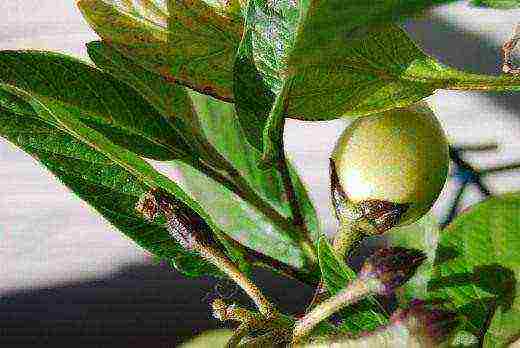 Pepino, Melon Pear, or Sweet Cucumber
Pepino, Melon Pear, or Sweet Cucumber
As we grow, we tie the stems to the trellis located above. An untied plant without pinching, under the weight of its mass, droops and lays down on the soil, the stems take root and practically do not bear fruit.
Grassing and tying to the trellis allow plants to rationally use the radiant energy of the sun. The fruits are not tied to the trellis, long and strong flower stalks allow you to simply hang them on the trellis.
During the growing season, the plants often have a pronounced inversion - unremoved stepchildren overtake the apical shoot in growth and grow 1-2 knots before the next inflorescence. Leaving them one by one on the stem, you can form an additional stem that prolongs the fruiting of the plant.
Further care of plants is usual: loosening the soil in rows and aisles, removing weeds, regular watering, feeding, destroying pests and pathogens. We carry out the first feeding after the seedlings take root. We use an infusion of mullein (1:10) or bird droppings (1:20). The second time we feed the plants during the formation of fruits with the indicated infusions or infusion of green fertilizer (1:20). After feeding the plant, water it. The solution that gets on the leaves is immediately washed off with water.
We do not use mineral fertilizers. If necessary, you can use mineral fertilizing (10 g of ammonium nitrate, 15 g of superphosphate and potassium sulfate per 10 liters of water) during the flowering period and at the beginning of abundant fruiting.
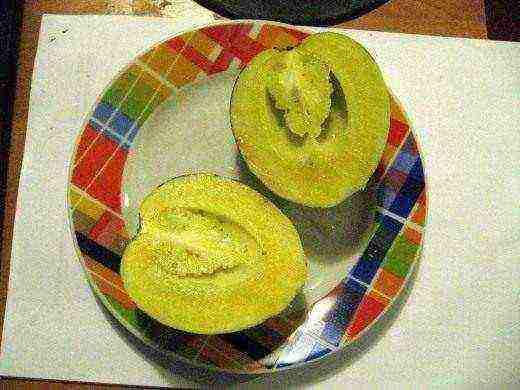 Pepino, Melon Pear, or Sweet Cucumber
Pepino, Melon Pear, or Sweet Cucumber
Protection from pests and diseases
The complex of pests and diseases with extremely limited cultivation of pepino has not yet formed. Only a few types of harmful organisms have found a new fodder plant, causing harm to it. Among them are the Colorado potato beetle, spider mites, aphids (melon, green peach), whitefly.
Pepino and diseases are also affected: the seedlings are "mowed" by the black leg, when the soil is waterlogged, root bacterial rot develops, in the second half of the growing season, if conditions are favorable for the development of the pathogen, phytophthora may appear.
Plants are also susceptible to nightshade viruses. There are isolated cases of infection with the leaf bronzing virus - the affected leaves with a bronze tint turn black and curl. The plant noticeably lags behind in growth and does not form normally developed fruits. To prevent the contamination of other plants by sucking pests (aphids, leafhoppers), such a bush should be removed.
There are no registered preparations for the destruction of pests in the cultivation of pepino in Ukraine.If necessary, you can use insecticides and fungicides recommended for protection against pests and diseases of tomato, eggplant, belonging to the same biological group as pepino (Solanaceae family). Experts note the increased sensitivity of pepino to some drugs and consumption rates that are acceptable for other vegetable nightshade crops. Therefore, it is advisable to first treat one stem of the plant with a preparation with the recommended consumption rate to make sure that the working solution is not toxic.
It is necessary to protect pepino from pests not only in the open field in summer, but also mother plants overwintering indoors. It is possible to limit the development of spider mites, whiteflies, and aphids on plants in winter by treating them with insecticides during the preparation and transplantation of mother plants for overwintering. Use the recommended preparations for the destruction of these pests on tomatoes and eggplants. If the drugs are compatible, the treatment can be carried out with a mixture of insecticide (to destroy aphids and whiteflies) and acaricide (to destroy spider mites). But this must be done before transferring the plants to the dwelling, so that unpleasant and harmful fumes of drugs from plants and soil are eliminated.
 Pepino, Melon Pear, or Sweet Cucumber
Pepino, Melon Pear, or Sweet Cucumber
In winter, if it becomes necessary to treat pests, it is best to use decoctions or infusions of phytoncidal plants (marigolds, tobacco, makhorka, yarrow, onion husks, garlic), which must be prepared in summer. Spray the plants with infusions and decoctions after 5-7 days.
If there are no phytoncidal plants, but there is a need to get rid of pests, the treatment is carried out with actellik, 500 EK, c. E. (2 ml per 1 liter of water) or confidor, c. R. K. (2-2.5 ml per 1 liter of water) in a separate room, observing all safety measures. After drying, the plants are brought into the living room.
Preparation of mother plants
Fruits are still ripening on plants, and you should already take care of growing mother material for the next season. We begin to grow mothers from stepchildren of plants in mid-August so that by the end of the growing season they have a well-developed root system.
Plants can be prepared for overwintering in different ways:
- Grow young plants from stepchildren rooted in June and July. Shorten the main stems, leaving only a few lower stepsons. The root system of plants has already been formed, it is not depleted by fruiting. With proper care, plants can safely endure the winter.
- Grow plants from stepchildren in the second half of August. Stepchildren, grown in September, do not have time to form into a strengthened plant with an early cold snap in the fall.
It is better to plant stepchildren to mother plants, where they will be protected from the sultry rays and provided with moisture. - Grow plants from the stepsons of a rooted shoot. To do this, you need to leave one shoot of the lower tier on the bush, give it the opportunity to grow, and then tilt it and pin it to the soil. When in contact with moist soil, more than a dozen stepchildren grow on the shoot and they are already with the root system. It remains to cut the stem and plant the finished plants.
 Pepino, Melon Pear, or Sweet Cucumber
Pepino, Melon Pear, or Sweet Cucumber
Before planting, cut 1 - 2 lower leaves and plant the plant in a container slightly deeper than the removed leaves, so that additional roots are formed. On the aerial part of the stepson, leave 5-7 leaves, from the sheaths of which new shoots will grow, forming a compact plant.
Preservation of mother plants
Plants, prepared for overwintering, at the end of September, when the temperature at night drops to 14-15 ° C, we dig up with a lump of earth, without injuring the root system. We place it in a container corresponding to the volume of the dug out coma. Pour expanded clay for drainage and a layer of prepared soil mixture at the bottom of the container.In the bottom of the container, we make drainage holes for the drainage of irrigation water.
We leave the transplanted plants outside for several days so that they take root better. Growth processes in pepino are suspended at a temperature of 12-13 ° C. Therefore, we bring the plants into the room on time. We place them on the sills of south-facing windows and take care of them like ordinary houseplants.
Plants exposed to the north can shed their leaves during frosty periods when the room temperature drops below 10-12 ° C (taking into account the proximity of the leaves to the window frame). When the temperature rises, leaves grow back on the shoots in 2-3 weeks, stepchildren grow from their sinuses, and by the beginning of April they can already be rooted for reproduction. Plants respond with gratitude to the illumination, noticeably increase in growth, the leaves acquire a more intense color. If desired, overwintered plants can continue to be grown indoors (balcony, loggia), transplanted into a large container.
 Pepino, Melon Pear or Sweet Cucumber
Pepino, Melon Pear or Sweet Cucumber
When mother plants are harvested in larger quantities than can be placed in living quarters, the plant itself helps to solve the storage issue, its biological feature is the tendency to a dormant period inherent in woody crops and shrubs.
Mother plants can be stored in both light and dark rooms. Preparation for such storage of plants is as follows: watering and nutrition of plants is gradually reduced to a minimum, the temperature is gradually reduced to 5-6 ° C within 3-4 weeks. The metabolic and growth processes slow down, the plant sheds its leaves.
To prevent the development of fungal diseases, air humidity should be low, ventilation is good, and watering should be at such a level that the roots do not dry out. Under these conditions, the dormant period lasts up to 1.5-2 months (December-January).
With the onset of favorable light conditions, the plants are transferred to a bright room, watered with warm water, fed and grown until mid-April, when the time comes for the rooting of the grown shoots and stepsons.
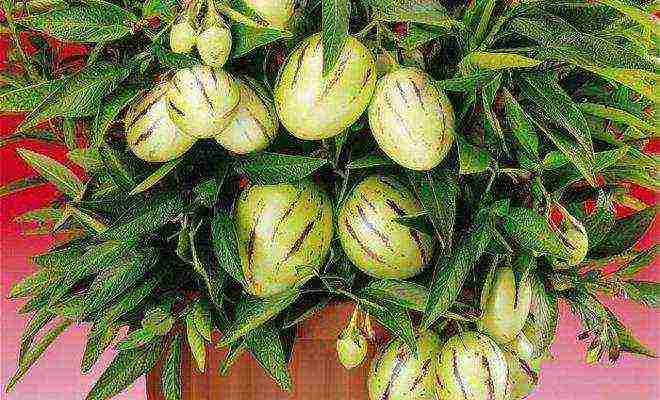
Pepino, or melon pear, is not yet a very popular houseplant. But for those who like to grow fruiting specimens at home, this plant will certainly be a welcome acquisition.
Is it easy to grow this plant at home, and even harvest the fruits? Let's figure it out.
Pepino from seed
You can grow pepino from seeds extracted from the fruits of the plant. However, if the fruit was picked immature, there is a risk that the seeds will not sprout. But do not be upset if you did not succeed in growing pepino in this way. The seeds of this plant can also be purchased at the store. When buying, pay attention to the quality of the seed: it should be light and have the correct rounded shape.
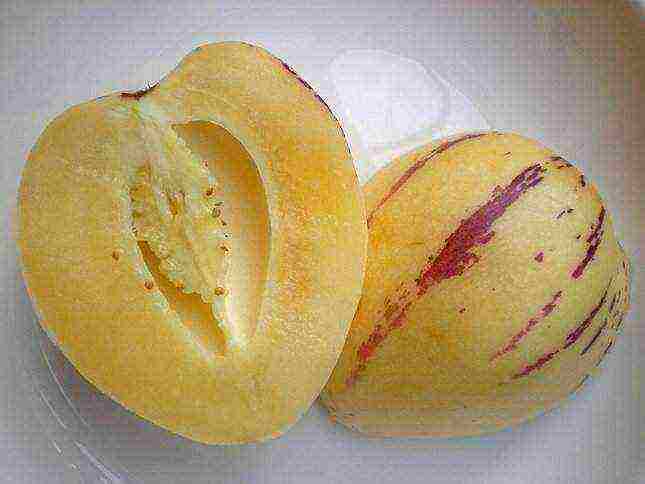
Pepino seeds can be extracted from the fruit or purchased from a gardening store
Pepino seeds should be sown at the end of November, since the plants develop rather slowly, and by the spring they will just reach the age when it is time to set fruit. The seeds do not germinate well in the soil, therefore, for germination, it is best to spread them on damp paper (toilet or filter paper). So that the moisture does not evaporate quickly, it is better to put the seeds on paper in a shallow container, cover with a film or a bag and put in a dark place.
Moisten the paper in the container every 2-3 days. When the seeds begin to hatch (this usually happens on day 10), the container must be transferred to a bright place. The germination temperature of seeds should not be lower than 24-26 ° С. A pick of seedlings should be done when the cotyledons of each of them fully open. They can now be planted in regular garden soil.

Dive seedling pepino
Vegetative propagation
Pepino seedlings grow very slowly.If you don't want to mess with the seedlings, you can try growing the plant by rooting stepchildren. They take root relatively easily (roots appear on the third day) and begin to bear fruit earlier than those specimens that were grown from seeds. It is best to root plants in February, planting stepchildren in peat soil.
Growing features
Place pepino should on south windowsillbecause the plant is very light-requiring. To water it is not worth too much, since pepino tolerates overflows rather poorly. The plant should be kept when temperature 25 ° C during the day and 20 ° C at night. At lower temperatures, there is a risk of losing the ovaries.
When the pepino bushes begin to grow strongly, they can tie up to the props. In a highly bushy plant, stepchildren must be periodically removed, since they inhibit the formation of fruits. A lush bush can be neatly shaped pruning... It is best to form it in the form of a tree.
Pepino fruit
To help the flowers get dusty, the plants can be shaken gently during flowering. To prevent inflorescences from kinking during the formation of fruits (which are quite large in pepino), the ovaries should be carefully tied to the stem located above the knot.
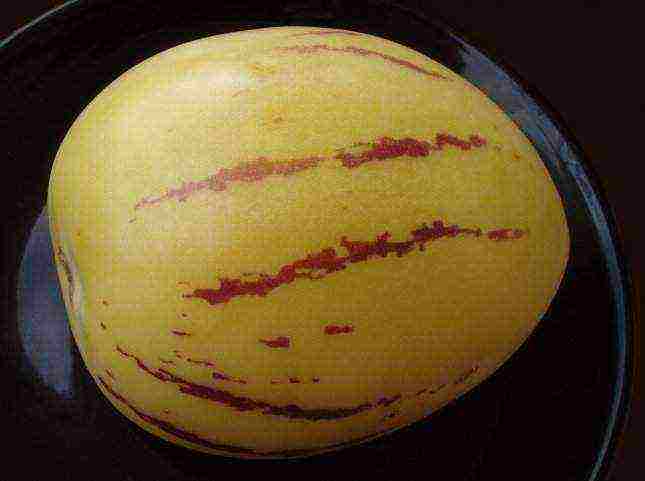
Pepino fruits can be stored in the refrigerator for several months.
You can harvest the crop within 4-6 months after planting the plant. Ripe fruits reach the size of a goose egg and have a yellowish-creamy color. They can weigh from 200 g to 750 g. It is very important to ensure that the fruits do not overripe, otherwise they will lose their taste. Thanks to their dense skin, pepino fruits can be stored in the refrigerator for up to several months.
Pepino leaves look like pepper leaves, flowers resemble potato flowers, and taste like a real melon.
Last March, I asked our gardeners, "Did anyone grow PEPINO?" Nobody responded, but I really wanted to experiment)) Now I will write about my modest experience of growing this miracle
I have long wanted to try to grow pepino. Probably many have heard that Pepino is a melon pear. Before deciding to buy a bag of these seeds, I read a lot of articles and decided that I could give it a try. There are 2 varieties of pepino that grow here. These are Ramses and Consuelo. I bought seeds at the same time as the seeds of other vegetables, that is, in the month of February and was very surprised that they recommend planting seeds in September-October. I planted it in February (there were 5 tiny seeds in a bag), the Consuelo variety.
Very small sprouts appeared after 5-7 days. Days passed, and they did not grow at all, and then 3 of them bent safely. There were only two left and after 2 months they became pretty strong.
I decided to plant one in a greenhouse with peppers and eggplants, and left the other in a pot. As a result, a gorgeous bush grew in the greenhouse, strewn with numerous stepchildren, and in the pot it remained the same small. After some time, the bush bloomed very profusely in the greenhouse. The flowers are similar to potatoes, but more striped.
It was very hot in the greenhouse ... up to +50, so there were a lot of flowers, and the fruit was not tied, which made me very upset. I read that in the summer months the plant does not set fruit even with abundant flowering, and this is mostly due to too long daylight hours. It is known that in Peru and Chile (regions of origin of pepino) daylight hours do not exceed 14 hours and even in the subtropics they achieve the best results when grown in the winter months.
And suddenly, somehow, I saw five fruits ... small. That was really joy. Every time I entered the greenhouse, I was afraid not only to breathe, but also to look at them. Also, having read that the stepsons take root remarkably well, I cut off several stepsons and immediately stuck them in the ground next to them.I was sure that nothing would work out, since the earth is clayey, heavy ... but they all took root very quickly and bloomed quickly
As a result, September was approaching, and only two of the five fruits remained, the rest fell off.
Thus, it is grown for an interesting experiment rather than a harvest. Experienced "pepinists" are happy with one fruit on the bush. At the end of September, I decided to cut these 2 fruits and put them for ripening at home. It is believed that you can remove the fruits when lilac stripes appear on them.
After 20 days, one of the fruits was ready to eat. Such a fragrant smell was in the air that I wanted to cut it. HURRAH!!! Everything worked out ... delicious and juicy PEPINO fruit !!!!
